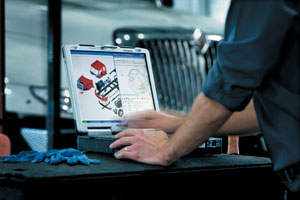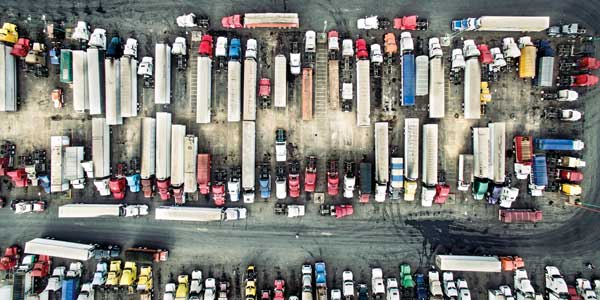Maintenance software has been around long enough to prove itself as a viable tool not only to schedule maintenance, but also to track vehicle and component trends, control inventory and labor costs and help keep equipment on the road and earning revenue.
Recently, however, with the Federal Motor Carrier Safety Administration (FMCSA) Compliance, Safety and Accountability initiative, keeping detailed records on vehicle maintenance has become imperative.
Improving CSA scores
“We wanted to reduce our costs and improve our quality,” said John C. Washington, manager of fleet maintenance and compliance for Maxum’s Western Division. “The quality improvement is evident in the CSA scoring and the feedback from our drivers.” The savings were significant as well, he added.
Maxum West, the Western Division of Maxum Petroleum, scored well in CSA safety ratings with a 23.9 in August 2011, the month the division first implemented Dossier (from Arsenault Associates) maintenance management software. As of March 2012, that good score had improved to an excellent 13.1.
Maintenance is one of seven critical elements in a fleet’s overall CSA rating. The numbers represent percentile ratings compared with similar fleets. Thus, the 23.9 maintenance rating placed Maxum West in the top quarter of its class. With a score of 13.1, the fleet is now in the top 14% for maintenance safety.
According Washington, Dossier software was implemented in conjunction with a successful program to bring fleet maintenance in-house from third-party providers. The project involved equipping and staffing eight full-time maintenance shops in California, Nevada, Arizona, New Mexico and Texas with 15 mechanics and 3 administrators.

“In many cases, fleets that install new software and workflows can’t quantify their savings and improved productivity because they don’t have historical data,” said Bob Hausler, vice president of marketing and technology at Arsenault. “In Maxum’s case, we can see they were already doing a good job, and even the step from good to great yields a huge savings.”
Hausler added Arsenault has just released Dossier version 6.2, which includes FinanceLink, a menu-driven way to export parts purchasing data to virtually any financial application. “It’s as simple as choosing the data desired from a drop-down menu. The export can include up to 15 key pieces of data such as dates, vendor, purchase order number, general ledger code, etc.”
Hidden profits
When was the last time you performed a really thorough parts inventory count and/or reorganized your parts room? Chances are if you haven’t done so within the last 12-18 months, you will discover up to 30% of your parts are either obsolete or are collecting dust from not being used. Everyone hates to take the time to do mundane tasks, but the dividends can be so large they can’t be ignored. For example, a typical fleet of 100 Class 6 to 8 power units can easily have an inventory value in excess of $75,000 between standard parts and consumables. Converting 30% of this value into cash or usable parts by returning or exchanging them with your parts suppliers can amount to $22,500 or more! These are savings your department can add directly to your company’s bottom line. Another benefit of this reorganization effort is that you will discover additional useable parts you didn’t know you had, which means you have them in stock and can cut down on your next parts order.
| Reduced maintenance costs • Scheduled repair work becomes 80% of ALL work performed • Vehicles go from PM service to PM service without a breakdown • Provide clear instructions to technicians for each unit serviced • Identify and reduce rework by mechanics and vendors by 85% • Increase warranty recapture dollars by 50% • Identify high cost units and why they are high • Make 100% of your maintenance decisions based on facts • Provide an easy method to schedule and track problem drivers and inventory • Reduce on-hand quantities by up to 30% • Identify non-used and obsolete parts to save 10% • Reduce vehicle downtime due to out-of-stock problems • Cost reduction of 3% to 5% by price comparison shopping • 50% increase in real dollar warranty re-capture • Physical inventory count becomes easier • Stop duplicate orders by knowing where to find existing parts • Stop excess stock on-hand by using parts cross referencing • Track and control fuel, oil and other fluids as inventory items |
Choosing maintenance software
In today’s fast moving business world, you have to be well-organized and allow your staff to easily access the information needed on a daily basis. Your fleet team is working much harder than it needs to, and you are operating at a significant disadvantage compared to your competitors if you don’t have a fleet maintenance computerized software system.
You can’t control what you don’t know. To control your mobile assets, you need to know exactly how many pieces of equipment you have, what their specifications are, what their maintenance history is, what PM schedules apply, when their next service is due, which warranties apply to each asset and which ones are still available to you, as well as other operational and administrative information.
‘10%’ solution to reduce costs
Fleet managers are charged with two primary tasks: keep your fleet operating at its optimum performance level to ensure equipment availability, and do so at the absolute least cost possible. Cost control is only possible by measuring on a unit-by-unit basis. Trying to control cost on a big-picture collective basis simply doesn’t work, as your problem units and the exact reason they are problem units will continue to elude you and eat away at your limited operating budget.
Try implementing what we call the “10% Solution,” which says that if you can identify your top 10% worst operating units, you will be able to make business decisions that reduce your overall fleet cost by as much as 20%, your downtime by 40% and your aggravation by 80%.
Keep in mind your oldest units are not always the most costly units. To identify your problem units without fleet maintenance software is very difficult and time consuming because you need to search through thousands of repair orders for the necessary data. If you must rely on your accounting department for costs, make sure they give you unit-by-unit costs and that they do not include fixed cost items like depreciation, insurance premiums, licensing fees, etc.
Evolving technology, benefits
Alan Tomlinson, eastern region solution engineer for TMW Fleet Maintenance Software, said that maintenance software has evolved in the last few years and now provides even more benefits. According to Tomlinson, “There are three primary changes. First of all, the need for reporting has increased, particularly on high volume consumables in the maintenance department. Fleets need to track and respond to how assets are using equipment and want to know when use is irregular or unusual.”
One example, he noted, is tire wear. With the cost of tires increasing by 30% to 40% in the past few years, any aberration in wear or replacement has a significant impact on maintenance costs. Trucking companies need software to help keep track of tire performance and wear. In addition, fleets are addressing the needs to be environmentally responsible, which means they are following external directives that require increased reporting of maintenance management.
These days, shop efficiency is more important—because of its effect on profitability and overall operating ratios. Tomlinson noted, “There are two components that are measured: direct vs. indirect costs (direct costs are directly attributable to activity in the maintenance department, while indirect costs are associated with idle labor—an 80+% ratio is most desirable). The other component is the comparison of actual costs vs. standards. This means comparing what the shop is doing versus best in class performance for similar tasks. If it takes you 10 hours to rebuild a transmission, but the standard is only eight hours, that ratio indicates your mechanics are not performing efficiently. What software has been able to do is provide this reporting in real-time, which helps managers be more responsive to how efficient the shop is operating.”
The third change is the increase in compliance, specifically driver vehicle inspection reporting (DVIR). Tomlinson noted that electronic processing improves accuracy and reporting time.
Going forward, Tomlinson believes maintenance outsourcing will continue to be a viable option for fleets. He said, “Fleet maintenance software is imperative in managing outside customers in scheduling, cost management and warrantee recovery. Current in-house maintenance departments will become independent businesses that have to manage all aspects of maintenance work for these outside customers. We will see an increase of ‘mobile technology solutions,’ meaning more handheld devices, more apps for those devices and a greater need for inter-connectivity between the company data warehouse and the fleet in the field.We’ll also see an even greater need for real-time data. This will impact preventive maintenance and warranty recovery. The old ‘time is money’ adage applies here. The faster we can manage PMs or recover warranty dollars, the greater the impact these have on a company’s operating ratio.”


